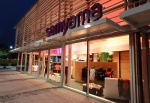Last month the USGBC Northern California Chapter (USGBC NCC) and Environmental Building Strategies (EBS) hosted a LEED version 4 Educational Series led by Kena David, Assistant Sustainability Manager at BCCI Construction Company, and Kristen Magnuson, Project Coordinator at EBS providing a credit-by-credit analysis of changes the Interior Design & Construction (ID+C) green building rating system. The following surmises some of the key changes with LEED v4 ID+C.

LEED Dynamic Plaque (USGBC)
In an attempt to put greater emphasis on performance, the U.S. Green Building Council (USGBC) has made some significant credit weight shifts with LEED v4 ID+C. Pushing the envelope of sustainability in the built environment has always been the goal of the USGBC and LEED rating systems. LEED versions 1.0 through version 2009 have been scrutinized over the years for focusing too much on meeting a one-time certification level (from Certified to Platinum) rather than performance with lasting energy efficiency and resource conservation. The newest version of LEED, v4; however, has modified the point distribution among the credit categories to align with performance after a project is certified. It is anticipated that the introduction of the new Dynamic Plaque which provides a live summary of performance measures (including energy use, water use, waste reduction, etc.) will helped certified LEED projects maintain targeted credit categories into the future.
Location and Transportation
In a few credit categories, LEED v4 ID+C has changed dramatically. Former site credits under the previous versions of LEED Sustainable Sites (SS) category have been moved to a new category, Location and Transportation (LT). LEED v4 focuses on Neighborhood Development as opposed to v2009 SS which emphasized location within a LEED certified building. LT has also changed the point distribution for the familiar LEED v2009 SS credits from an all or nothing credit compliance to a gradient of points. For example, instead of providing 10 basic services for Community Connectivity, LEED v4 LT credits will award points based on the total number of basic services.
Material Credits
The next greatest change in ID+C v4 has been with the material credits. The first change is that Construction Waste Management (CWM) is no longer an optional credit and is now a prerequisite.
C&D Waste Management
For the Construction and Demolition (C&D) waste management credit, Option 1 requires 50% diversion and that C&D waste is separated into at least three waste streams; and Option 2 requires 75% diversion and that C&D waste be separated into at least four waste streams. Different waste streams can include:
- Commingled waste sent to a sorting facility (counts as one stream).
- Separated material that is either reused on-site or off-site or divided material which is sent to a recycling facility (i.e., metal sent to a metal recycler, each separate material counts as one stream)
ADC for construction waste diversion
LEED v2009 allowed ADC (alternative daily cover) to contribute to the overall diversion rate of Mixed C&D whereby LEED v4 does not. The only manner in which a debris tag with Mixed C&D stated will be accepted is if the project team can verify that it does not contain ADC as part of the diversion percentage.
Building Materials
LEED v4 revisions to materials credits now underscore health and wellness issues and have been modeled after Living Building Challenge Red List compliant guidelines as well as Google’s Healthy Materials Program, which utilizes its own stringent criteria for building product selection. Points once associated with LEED v2009 Materials & Resources calculator have been condensed into Option 2 of Building Product Disclosure and Optimization – Sourcing of Raw Materials and are now only worth one point. .
Additionally two new material certifications that have been introduced with LEED v4, Health Product Declarations (HPD) and Environmental Product Declarations (EPD).

Thornton Tomasetti’s new San Francisco office was one of only 25 projects worldwide selected to participate in the LEED v4 beta program for CI. The project is targeting Platinum certification.
HPD for Material Ingredient Reporting
With an emphasis on healthy building material components and the disclosure of potential hazardous chemicals within products, HPDs move beyond just focusing on reclaimed material and recycled content ratios towards the importance of product ingredients relating to human health from the manufacturer to the end user.
EPD for Life Cycle Impact
Diving further into long-term sustainability, EPDs pinpoint the complete life cycle and carbon impacts of products, from the manufacturing process to lifetime use to product disposal. EPDs take a product’s Life Cycle Assessment (LCA) and presents its impact in an objective, third party verified declaration.
 To learn more about LEED v4 ID+C, download a copy of the credit-by-credit presentation.
To learn more about LEED v4 ID+C, download a copy of the credit-by-credit presentation.
View other presentations in the LEED v4 Educational Series.
BCCI provides workshops and ongoing training on a variety of Green Building topics as well as preparation for the LEED AP and LEED GA exams. Request a seminar for your company or organization.











